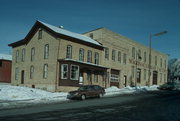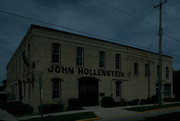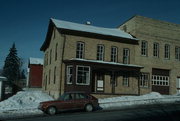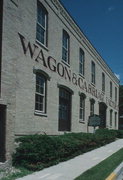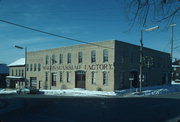Property Record
NW CNR OF N GERMAN ST AND E BRIDGE ST
Architecture and History Inventory
| Historic Name: | Hollenstein Wagon and Carriage Factory |
|---|---|
| Other Name: | Hollenstein Wagon and Carriage Factory Museum |
| Contributing: | |
| Reference Number: | 15261 |
| Location (Address): | NW CNR OF N GERMAN ST AND E BRIDGE ST |
|---|---|
| County: | Dodge |
| City: | Mayville |
| Township/Village: | |
| Unincorporated Community: | |
| Town: | |
| Range: | |
| Direction: | |
| Section: | |
| Quarter Section: | |
| Quarter/Quarter Section: |
| Year Built: | 1876 |
|---|---|
| Additions: | 1888 |
| Survey Date: | 1975 |
| Historic Use: | industrial bldg/manufacturing facility |
| Architectural Style: | Commercial Vernacular |
| Structural System: | |
| Wall Material: | Cream Brick |
| Architect: | |
| Other Buildings On Site: | |
| Demolished?: | No |
| Demolished Date: |
| National/State Register Listing Name: | Hollenstein Wagon and Carriage Factory |
|---|---|
| National Register Listing Date: | 7/27/1979 |
| State Register Listing Date: | 1/1/1989 |
| National Register Multiple Property Name: |
| Additional Information: | A 'site file' exists for this property. It contains additional information such as correspondence, newspaper clippings, or historical information. It is a public record and may be viewed in person at the Wisconsin Historical Society, State Historic Preservation Office. FLAT ROOF FACTORY PORTION W/GABLED HOLLENSTEIN HOUSE FACING BRIDGE ST. HOLLENSTEIN WAS A SWISS WAGON MAKER WHO SWITCHED TO WAGON MFG. FRAME HOUSE VENEERED IN BRICK TO MATCH FACTORY. OLDEST PORTION OF FACTORY JOINS HOUSE AT E. END. STILTED SEGMENTAL ARCH LINTELS. This little factory is a microcosm of small-scale industrialization, illustrating America's nineteenth-century transition from cottage-based to factory-based production. Swiss immigrant John Hollenstein moved to Mayville in 1873 to start a wheelwrighting and wagonmaking business. Within three years, he erected either his house, the original portion of the factory, or both. Like many tradesmen who became factory owners, Hollenstein attached his place of business to his home, and he boarded several of his employees, perpetuating a traditional artisan-apprentice relationship and a pre-industrial connection between workshop and family life. Within a decade, demand for Hollenstein’s wagons, sleighs, buggies, coaches, and omnibuses had grown enough to warrant a major expansion. He erected a 40-foot-by-66-foot addition in 1888; two years later, he added a two-story powerhouse with a ten-horsepower steam engine to the north side. He prospered until the 1910s, when mass production of automobiles and trucks rendered his business obsolete. Each stage of growth is clearly visible on the building. At one end stands Hollenstein's two-story post-and-beam house, a vernacular, side-gabled structure. Originally clad in clapboard, the house acquired a cream-brick veneer to match the factory. Large segmentally arched windows light the house, and a full-width veranda with dentils and scroll brackets spans the facade. The factory’s oldest portion, adjoining the house on the east, is a two-story cream-brick structure with a flat roof and segmentally arched windows. Brick stringcourses mark the original roofline. When Hollenstein added the largest portion of the factory, again using cream brick, he raised the roof of the old building and visually tied the old and new structures together with a corbel table. On the north side of the complex are the last two additions, including the two-story powerhouse, which has lost its boiler, engine, and smokestack. The painted legend "Wagon & Carriage Factory" replicates the original sign. The Mayville Historical Society now operates the complex as an industrial museum. |
|---|---|
| Bibliographic References: | Buildings of Wisconsin manuscript. |
| Wisconsin Architecture and History Inventory, State Historic Preservation Office, Wisconsin Historical Society, Madison, Wisconsin |

